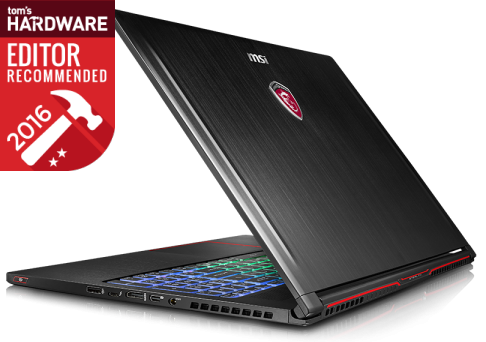MSI GS43VR Phantom Pro Gaming Laptop Review
Why you can trust Tom's Hardware
Synthetic Benchmarks
The MSI GS43VR Phantom Pro is the first laptop with Intel’s 7th generation Kaby Lake processor to land in our lab. It consists of an Intel Core i7-7700HQ, a 6GB Nvidia GeForce GTX 1060, 16GB of DDR4-2400 memory, a 128GB M.2 SSD, and a 1TB 7200RPM HDD. We don’t have any other Kaby Lake models to compare it to yet, so the best comparisons we can draw are against several Skylake laptops with similar specifications.



First in our line of comparisons is MSI’s very own GS63VR Stealth Pro which we reviewed back in December. It features a last generation Intel Core i7-6700HQ CPU, a 6GB GTX 1060 GPU, 16GB of DDR4 memory, a 256GB M.2 SSD, and a 1TB 7200RPM HDD. Hailing from the same GS line as the Phantom, the Stealth Pro is most similar system in terms of size, weight, and aesthetics, although it has a wider 15.6" display.
Our second competitor is the Gigabyte P57W v6. It also features an i7-6700HQ CPU, a 6GB GTX 1060 GPU, 16GB of DDR4 memory, 256GB of M.2 SSD storage, and a 1TB 7200RPM HDD. The Gigabyte received top marks for its performance, outscoring all other GTX 1060 laptops in its class. It also has a much wider 17.3" display, which had low average grayscale and color errors.
Finally, to illustrate how well the i7-7700HQ and GTX 1060 fare against a higher end system, we’re throwing the Acer Predator 17 into the mix. The Predator 17 contains an i7-6700HQ CPU, a GTX 1070 BPU, 16GB of DDR4 memory, two 128GB M.2 SSDs in RAID 0, and a 1TB 7200RPM HDD. The Predator was well received because of its excellent performance, which rivaled that of another GTX 1070-based laptop with an overclockable CPU.
3DMark
3DMark’s software includes a handful of taxing benchmarks. Its Fire Strike, Fire Strike Extreme, and Time Spy tests are primarily GPU-based, but the CPU performance also comes into play. The MSI Phantom Pro takes second place behind Gigabyte's P57W overall, if only slightly, but the Phantom Pro's Physics and CPU scores do stand out among the 1060-based laptops.



Cinebench R15
Cinebench features both a single core and multicore test and a GPU-influenced OpenGL shading test. The competition is tight during the CPU benchmarks, but the Phantom Pro takes the lead thanks to its 7th-generation Kaby Lake processor. The i7-7700HQ shines in the multi-core test in particular, scoring about 6% better than the Skylake laptops. OpenGL performance sees slight improvement as well, but the Phantom Pro can't beat the more powerful Acer in a graphics-based test.
CompuBench
The Phantom Pro’s i7-7700HQ delivers another tangible performance increase over similar systems with lesser processors, performing between 6% and 9% faster in the Video Processing test than the Stealth Pro and P57W, respectively. But the Predator 17 still outperforms all laptops thanks to its GTX 1070 GPU. The Bitcoin Mining test is more GPU-focused than the Video Processing test, which leaves the performance differences between the three GTX 1060 laptops a virtual toss-up.
Get Tom's Hardware's best news and in-depth reviews, straight to your inbox.
IOMeter
To test read and write speeds, we run IOmeter from the system's primary drive. Our Phantom Pro has a 128GB SK Hynix HFS128G39MNC-3510A, which we’re comparing to a 256GB Samsung SM951 in the Stealth Pro, two 128GB LiteOn CV1s running RAID 0 in the Predator 17, and a 256GB LiteOn CV3 in the P57W.


The SK Hynix SSD has decent 4K Random speeds, rivaling the Stealth Pro’s SM951, making it ideal for small Windows system files. On the other hand, our SK Hynix SSD exhibits poor 128K sequential speeds, which translates to slower load times for your games, pictures, music, etc. The SK Hynix is a lot faster than the 1TB HGST Travelstar 7K1000 on board the Phantom Pro, but with such limited space you’re better off installing your vital applications on the SSD and leaving your media files on the HDD.
PCMark 8
Instead of the typical preloaded tests that are included in PCMark 8, we use the Microsoft Office and Adobe Creative suite, which provide more accurate real-world performance results. Intel’s updated Kaby Lake processor appears to have a tangible impact on performance. Previously the Predator outperformed the two i7-6700HQ/GTX 1060 configurations thanks to its GTX 1070 GPU, but the Phantom Pro pulls ahead of the Predator despite the latter’s stronger GPU. We notice a significant performance boost during the Adobe Creative Suite workload. (As we continue to note, on this reduced scale, the differences look more pronounced than they actually are.)
Current page: Synthetic Benchmarks
Prev Page Introduction And Product Tour Next Page Gaming Benchmarks-
Clamyboy74 The VR signifies that it is VR ready (gtx1060), not that Toms has to do VR benchmarks. VR benchmarking is still in its early stages, and it is a pain to set up. Better to just play a VR game and see if it runs smooth.Reply -
ttt_2017 USE THOSE NOTEBOOKS HEATPIPES AND FANS ON A LOW PROFILE SINGLE SLOT GTX 1060/1070 what is stopping you ?Reply
MSI DO IT. YOU CAN DO IT.
WE WANT GTX 1060/1070 LOW PROFILE SINGLE SLOT CARD IT IS DOABLE. LOOKING AT NOTEBOOKS 1060/1070 with Notebook cooling tells us it is DOABLE so DO IT.
dont just give us cheap GTX 1050 low profile card with a dual slot cheap heatsink and two fans .
use notebook style cooling you can make SINGLE SLOT LOW PROFILE HALF HEIGHT cards AND EVEN GTX 1060/1070 and not only GTX 1050


